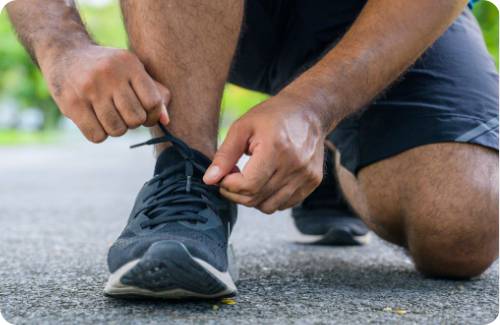How to start running if you are overweight?
Running is an activity accessible to everyone looking to gradually reintegrate sports into their lives based on their capabilities and availability. Often taken up to quit smoking, lose weight, or simply get back in shape, running, even for those already in good health, can be a challenge.
As all running enthusiasts will tell you, this activity improves the quality of life, boosts self-confidence, and contributes to overall better health. However, for those who are overweight, the idea of taking up running may seem complicated, or even impossible. By following simple advice, it's possible to improve your condition, physical fitness, and endurance.
In this article, we will explore various topics such as the specific challenges faced by overweight runners, the risks to avoid, and how to train and progress despite these difficulties. Here are the i-Run's experts answers to these questions.
I. Overcoming difficulties and preventing dangers in overweight running
In the world of running, being overweight is defined as an excess weight of more than 10 to 15 kg, depending on the runner's height. This excess weight is considered inactive, not contributing to movements like muscles, and even hindering locomotion. It's like you are running with a backpack or a scuba tank.
a) What difficulties do overweight runners face?
Running with extra weight presents major challenges such as limited endurance and induce joint pains, especially in the lower back. Endurance is limited due to the imbalance between weight and leg strength during running, quickly leading to a muscle fatigue. Repeated shocks on joints, unabsorbed by postural muscles, can cause inflammation, resulting in joint pain during and after exercise.
b) What are the dangers of running while overweight?
Running with excess weight exposes an increased risk of ligament injuries (knees and ankles), muscle strains due to the lack of resistance from postural muscles to stride constraints, and lower back pain due to compression of intervertebral muscles under repeated impact.
Despite these risks, it is entirely possible for an overweight person to take up running. So, how can you run safely despite these challenges?
II. Tips for safely starting running in overweight conditions
First tips: Prepare for physical activity with appropriate equipment and environment
Before starting on your new sports adventure, make sure you are well-equipped:
- Shoes: Buy shoes specially designed for overweight runners (>80/85 kg for men and >70/75 kg for women). This will improve shock absorption, and improve your stability. Check our advices in this article to choose the ideal pair.
- Clothing: Choose clothes specifically designed for sweat evaporation while ensuring optimal comfort. Check out our Running Clothing Section to find yours.
- Compression accessories: Incorporate compression accessories, such as knee sleeves and lumbar belts. These help to stabilize joints, reduce the risk of injuries, and promote faster recovery after exercise. You can explore our selection of muscle support and joints protections.
- Walking poles : Walking poles can provide better stability and support during walking or power walking sessions. They help to distribute the weight more evenly, reduce the impact on joints, and improve overall balance. It can be a valuable piece of equipment to incorporate into your running sessions, especially if you're starting out, while overweight. Check out our selection of poles to help you in your running experience.
Finally, the terrain on which you train is also important: Choose soft surfaces over asphalt, as this reduces shocks, which will reduce the pressure too on muscles and vertebrae.
Second tips: Gradually increase the difficulty of your training
Avoid setting overly ambitious goals from the start, such as running 30 minutes without difficulty. Break down your challenge into manageable stages, going from 5 to 10 minutes before considering 20, then 30 minutes. Listen to your body: if running seems too challenging, consider power walking, alternate walking and running, or even stair climbing. Get used to more or less intense efforts to prepare your body for the next challenge.
Third tips: Perform additional exercises
- Leg muscle strengthening (squats, lunges): Ideal for increasing leg strength and resistance to support the impact of a stride (equivalent to 1.5 times body weight).
Exercise: Strengthen leg muscles by using stairs. Stand at the bottom of the stairs and go up and down on the first step. Ensure your entire foot is on the step to improve stability and reduce tension in the calves. Also, include arm movements to stimulate your heart.
- Train your proprioception to strengthen ankle and knee stabilizing muscles.
Exercise: Stand flat-footed on the floor. Rise on your toes and maintain the position for 20 or 30 seconds. Focus on a distant point to improve your balance. You can increase the difficulty by performing the exercise on one foot or increasing the maintenance time from 30 to 45 seconds.
- Cross-training: Improve your cardio with cycling sessions! Combining running with cycling train other muscle groups, improves leg mobility, breathing, and endurance without the constraint of body weight. Adjust the duration, intensity, and pace of your sessions accordingly.
- Include every day mini-challenges: Walk as much as possible. Set small daily challenges, whether it's walking at work during breaks with colleagues, covering a few extra meters each day by parking a bit further away, or prioritizing stairs over the elevator.
Running while overweight is not a barrier, as long as you take the time to run slowly and cautiously. Unlike other situations, physical preparation here has a particularly preventive nature, allowing you to continue training and achieve performance and weight loss goals. By following these tips, your physical condition will improve rapidly, allowing you to approach running with serenity and confidence.
At i-Run, we believe in the importance of physical activity, and we encourage you on this journey so that you can motivate yourself, surpass your limits, and look back with pride on the distance you've covered.
Remember, be unstoppable, BE #RUNSTOPPABLE.
YOU MIGHT ALSO LIKE...
How to choose a pair of running shoes?
Running is an accessible, economical, and practical sport. You can run whenever and wherever you want: before or after work, during your lunch break, day or night, in the city or in the woods—all you have to do is put on your running shoes, and off you go.
Then there's the all-important question: How do I choose the right pair of shoes to start running?
What are good shoes for heavy runners?
Choosing the right pair of running shoes can improve your performance and reduce the risk of injury. To make your choice, you need to consider various criteria related to your running and personal characteristics.
Heavy runners should pay particular attention to this criterion when choosing their shoes. Indeed, these shoes need to have additional reinforcement and cushioning to minimize the impact on the runner's joints and tendons.
Running should be fun. To keep it that way, we've compiled 6 basic rules that show what's important for feeling good in sports and for optimal recovery/preparation.
To integrate running training into your routine, you should listen to your body, respect it, and start with a rhythm that is tailored to you.



